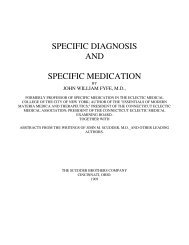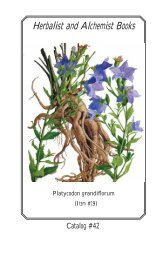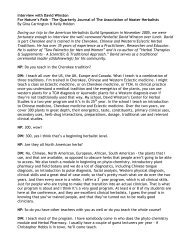MEDlCINAL PLANTS OF JAMAICA. PARTS 1 & 11.
MEDlCINAL PLANTS OF JAMAICA. PARTS 1 & 11.
MEDlCINAL PLANTS OF JAMAICA. PARTS 1 & 11.
Create successful ePaper yourself
Turn your PDF publications into a flip-book with our unique Google optimized e-Paper software.
CUCUMIS SATIVUS L. Cucumber.<br />
The fruit of the cucumber is also regarded as cooling. Its composition is similar to that of the preceding<br />
species. The seeds which contain about 25 per cent oil are used by the Europeans of the Transvaal as an<br />
anthelmintic. The oil contains vitamin A.Watt considered the seeds cooling and diuretic. (10, 16, 26, 27, 61).<br />
FEVILLEA CORDIFOLIA L. Antidote (Cocoon).<br />
We find that the use of the seeds (pounded with sugar and soap) as a dressing for wounds such as those<br />
made by rusty nails persists in Jamaica. The seed is also a common antidote for poisoning. (2, 5, 8, 11, 14, 15,<br />
16, 24, 27, 37, 50, 60, 61).<br />
SECHIUM EDULE Sw. Chocho.<br />
Though there appears to be considerable difference of opinion as to the variety of chocho (white or greenskinned)<br />
to be used there is a general opinion in Jamaica that it has some effect upon high blood pressure. The<br />
juice of the grated fruit is taken and doses have been variously stated as 1 teaspoon three times a week or (no<br />
quantity defined) every eight days. (35).<br />
EUPHORBIACEAE<br />
ACALYPHA WILKESIANA (Muell.) Arg. Copper Leaf; Red Hedge; Headache Bush; Croton.<br />
Both in Jamaica and in other West Indian islands the leaf of this ornamental is used as a headache<br />
poultice. Sometimes the leaves are moistened with bay rum but they may be used alone. Tea made with the<br />
leaves is sometimes used in the Grenadines as an internal treatment. A. indica L. is said to contain an alkaloid<br />
"acalyphin". (13, 37).<br />
ALCHORNEA LATIFOLIA Sw. Loblob; Dove Wood; Jimmy Wood.<br />
The leaves of the loblob are utilised by some as a tooth-ache cure: the leaf is chewed and the extracted<br />
juice held for a while in the mouth to "soak the tooth". A pipe is then smoked and the pain is said to be relieved.<br />
The leaves are also applied to other local pains. Githens and Dalziel report a number of other uses for related<br />
species in Africa where they are employed as vermifuges, wound dressings. cathartics, expectorants, and in the<br />
treatment of gonorrhoea. urinary infections, diarrhoea, dysentery and ophthalmia. The plants are said to contain<br />
tannins and simple amaroid bitters. (7, 10).<br />
CROTON HUMILIS L. Pepper Rod; Small Seaside Balsam.<br />
Early Jamaican medical authors say that this pungent plant was much used in baths and fomentations for<br />
nervous weakness. Maya medicine men used it to treat venereal sores. The only use we are able to record in<br />
Jamaica today is as an insecticide which is said to kill bed-bugs. (5, 15, 56).<br />
CROTON LINEARIS Jacq. (Wild or Spanish) Rosemary.<br />
This plant, which has a pleasant aromatic odour. is much used by Jamaican peasants as a hair wash. As<br />
in Browne's day it is still used in baths for fever and colds, for the treatment of which a tea made with the plant<br />
may also be taken. Barham considered the plant to have all the virtues of rosemary and used the powdered leaf<br />
as a specific for colic. (1. 5, 15, 36, 37, 50).<br />
EUPHORBIA BRASILIENSIS Lam. Spurqe; Wart Weed.<br />
This plant should be included in the list of small herbaceous spurges the juice of which is used in the<br />
removal of warts and to make tea for colds. (37).<br />
EUPHORBIA HIRTA L. Spurqe; Checkweed (Grenadines) Wart Weed; Creeping Hairy Spurge;<br />
Australian or Queensland Asthma Weed.<br />
In Fiji this species boiled in seawater is reputed to be a cure for dysentery and, as in Jamaica, is also<br />
used as a poultice for boils.







